 Part One | Part Two
Part One | Part Two
Day Four – 0° 25′ South, 36° 3′ East, elevation 6800 feet
After breakfast, we said goodbye to Sand River. Their food and service was outstanding. The consensus was that the meals we ate there were comparable to any fancy dining establishment, which makes it more remarkable, since this kitchen was two hours from the nearest city, and six hours from Nairobi. We inquired and we’re told that they receive food deliveries twice a month, which must make menu planning quite an art.
On the way out of Masai Mara, we saw the by now commonplace zebras, gazelles, and wildebeest. We caught up to a small group of elephants, and then shortly after, spotted a male lion crossing the road. That was enough to consider pausing to admire the animal, when we caught sight of not one, but four more lions in the immediate area. One female was perched up on a small hill. Perfectly posed for photos. It did not take long for two other cars with safari tourists to join us. One even veered slightly off road to get a closer look. That was our cue to move on, since that was against the rules, and it spoiled the camera shots. There we were, barely thirty minutes into our trek north, and we saw something amazing again.
It took nearly an hour to reach the park exit, then another hour driving along rutted dirt roads to reach a paved roadway. Nonetheless, our driver was zipping along at sixty kilometers per hour, slowing down only for major potholes, and narrow up and down crossings over dry creek beds. Bernard drove on all sides of the road, avoiding the rocks, ruts, and holes, with a familiarity from fifteen years of trekking around Kenya’s national parks.
As we traveled outside the park, it was now easy to recognize the various Masai villages, with the circular arrangement of huts and fenced off areas for livestock. There were numerous groups of Masai men and boys herding cattle, goats, and sheep, wearing the colorful blanket coverups, and ironically sometimes chatting away on cell phones.
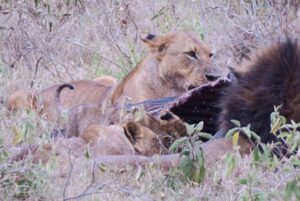 Some of the things we saw just can’t be captured on camera. The vastness of the Masai Mara, the forest of acacia tress in Lake Nakuro Park, or something as natural as dozens of bird species at home in the lake. Perhaps it’s the baboons on the side of the trail. They scatter into the trees before we can even focus our lenses on them.
Some of the things we saw just can’t be captured on camera. The vastness of the Masai Mara, the forest of acacia tress in Lake Nakuro Park, or something as natural as dozens of bird species at home in the lake. Perhaps it’s the baboons on the side of the trail. They scatter into the trees before we can even focus our lenses on them.
Lake Nakuro Park, at seventy-three square miles, is one of the smallest parks we will visit, but it’s home to zebras, wildebeest, warthogs, antelope, Rothschild giraffe, and rhinos. Within ten minutes of entering the Park, we caught sight of five white rhinos emerging from a muddy creek. More pictures were snapped, and then we hurried on to the Sopa Lodge, which sat atop a tall ridge overlooking the park, with a breathtaking view of Lake Nakuru in the distance. We were hungry from the long trek up from the Mara. The Kenyans love their Indian food, probably since workers and tourists venture there frequently. There seemed to be curry and Tandoor options at virtually every meal. Then, we set off for the afternoon game drive. Our driver picked up some chatter and we sped off where two other vans hunkered down by the side of the road. To our amazement, several lions were feeding on a freshly killed cape buffalo. One of the groups of onlookers had long telephoto lenses and cameras that probably cost more than our entire trip. We took the best vantage point remaining, and shoot loads of pictures and tons of video. Once we’d seen the poor beast ripped to shreds, we moved on to the lake itself, but not before encountering the rhinos again. We got as close as we could to the the marshy inlet at the north end of the lake, where we saw an incredible variety of birds, including white pelicans, black headed herons, yellow billed storks, a snake eagle, marabou storks, spar winged plover, and pink flamingos. We finally got to stand outside the confines of our vehicle, but a cape buffalo appeared to kept a watch over us. When the animal veered a little to close, we hoped back into the Toyota. In the end, the buffalo kept walking towards another of its kind beyond our perch. Crisis averted. The day was waning so we zipped back to the lodge for drinks and dinner.
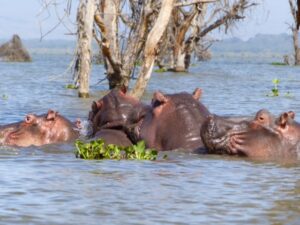 Day Five – 0° 45′ South, 36° 25′ East, 6200 feet elevation
Day Five – 0° 45′ South, 36° 25′ East, 6200 feet elevation
It was our first real sunrise, with gorgeous reds, bright yellows, and misty grays splayed across the eastern skyline. On the road again, we spot a total of eleven giraffes grazing near the road. One crossed a few feet in front of us. That might have been our wow moment if not for the fact that just after that, we spotted the rhinos crossing the road. We got closer than any zoo experience. As if that wasn’t enough, we finally caught up with a few baboons who didn’t scatter at the site of humans armed with cameras. All of this happened in a span of less than fifteen minutes. It will be tough to top that, but we’ve been continuously surprised every day.
As we drive along the two lane highway towards Lake Naivasha, there is a steady stream of motor cycles, cars, mini buses and trucks. The cars play a game of chicken passing the slower moving trucks, darting in and out of the oncoming, lane trying to get ahead of everyone and everything. It’s white knuckles for us, but Bernard is unfazed, even when an impatient driver passes a truck by maneuvering onto the shoulder. The landscape is dotted with small towns and open spaces, and a few private game parks, where we can spot zebras or antelope grazing. Yesterday, we caught site of a few baboons picking through the garbage which seems to scattered on the side of the road just about everywhere except, for the game parks. Apparently there is little or no recycling in this country, and what does exist can not come close to handling the volume of trash that’s generated.
At Lake Naivasha, we motor boated around the marshy edge of the lake and saw an amazing variety of birds including more storks, kingfishers, egrets, and pelicans. The highlight of the excursion were the hippos resting in the shallow water. One male surrounded by up to eight females or infants. They can stay submerged for up to five minutes. We kept a good, safe distance as we would be no match for an angry hippo. The last trick our boat driver did for us was to toss some raw fish into the water, whereupon an eagle came swooping down from the trees, and deftly snatched the fish, returning to its perch.
Our journey to Amboseli Park routed us back through Nairobi. This time we took a modern bypass around the southern tip of the city, past newly constructed housing developments on one side of the highway, but noticed one of the many shanty towns still standing, farther up on the other side. As we got out of Nairobi proper, we passed through a very typical suburban outlying city that one can see in most emerging countries. There is new construction everywhere of apartments, stores, and shopping centers, as people who work in the cities flee to find better, low cost housing. Of course, that accelerated growth brings with it a host of traffic issues, as urban planning can barely keep up with the needs of its newest citizens.
It was mostly two lane highway, with the last forty five minutes of the drive to the park entrance again on unpaved road, up some hills, passing through arid, desert like land, with low scrub. We encountered more Masai shepherding goats and cattle. After cresting one last hill, we got our first glimpse of Mount Kilimanjaro, the tallest peak in the African continent. Enough of the high clouds had dissipated to afford a view of the summit. It was a good sixty kilometers away, but the land is fairly flat until you reach the base.
Our objective was to reach the Amboseli Serena before dark, and we had thirty more minutes from the park gate. Bernard was zipping along the dirt roads when he picked up more chatter on his two way radio. He somehow managed to go even faster, bumping along, slowing down only for the larger divots in the road. We pulled up to an area where several other safari vehicles had stopped. We trained our binoculars to an spot at least several hundred yards from the road where lo and behold, we caught sight of not one, but two cheetahs. It was too far to see without magnification, but fine with the long lenses. We made it to the resort just as the sun was setting, and snapped more photos.
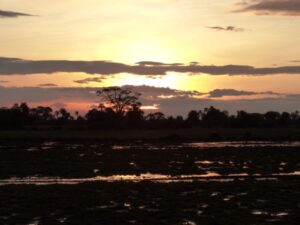 Day Six – 2° 40′ South, 37° 16′ East, elevation 3675 feet
Day Six – 2° 40′ South, 37° 16′ East, elevation 3675 feet
We set out bright and early, stopping just outside the gates to take some photos of Kilimanjaro, which looked magnificent in the early morning light. When we entered the park, the terrain was very arid, and devoid of much more than bits of short grass and the occasional Acacia tree. Now we found ourselves looking at a thriving, busy marsh, resulting from the mountain’s water runoff. It is home to hippos and hundreds of bird species. Even the elephants and Cape buffalo Wade into the marsh. You could see the water marks, halfway up their torsos. The other animals, zebras, antelopes, wart hogs, and wildebeest circumnavigate the wet areas. We also spotted hyenas and lions. The middle of the day provided some sorely needed down. Some of us sat poolside. Some got some nap time, and two of us booked massages. The Amboseli Serena Safari Lodge was separated from the game park by an electric fence, so the only animal threat were the monkeys who derived fiendish pleasure from pilfering food. The lodge had its own Masai “warrior” whose only job besides posing for photos was to shoo away the pesky primates. We got caught in a big downpour during our afternoon drive, resulting in a stunning end to end rainbow. We saw more elephants than just about anywhere else on the trip. Their routine was to emerge from the forest during the day, head out to the marsh for the food supply, and make their way back to the trees in the afternoon. Plus, more zebras, elephants, wildebeests, a family of hyenas, and a spectacular sunset awaited us.
Day Seven – 3° 18′ South, 35° 38′ East, 5710 feet elevation
We left Amboseli behind, but not before seeing some elephants up close. We crisscrossed paths with them as we passed through the abandoned lodge at Ol Tukuai. The drive to the border crossing took less than an hour from the time we exited the park. The climb up the hills afforded us a few last glimpses of the Kenyan side of Kilimanjaro, magnificent despite some modest cloud cover. By the time we reached the paved highway, the peak fell behind the hills. At Namango we reached the border crossing. We bid goodbye to Bernard, who escorted us to Kenyan customs and said hello to our new guide, Emanuel, repacked our bags in his truck and drove around to Tanzanian immigration. Then it was off to the city of Arusha, Tanzania. The highway was 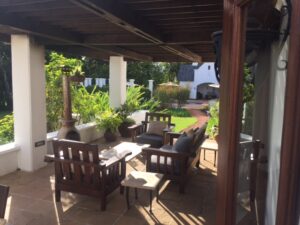 in much better condition, but the traffic was no different. Buses passing trucks, who in turn were lapped by cars. Emanuel stopped his truck, when was caught sight of some gerenuks, long necked antelope, that can only be found between the border area and Arusha. We also passed some local towns and more Masai villages. The shepherds were out everywhere with varying sized herds of cattle, goats, or sheep. The cattle have right of way, and must be given a wide berth. As we passed one small village, Emanuel slowed down and pointed out an enormous market day taking place. Everything seemed to be for sale including a live chicken offered by a man who walked right up to us. We moved on, arriving at the Arusha Coffee House by midday, for an outdoor buffet lunch. On the way out, we visited their artisan house, home to art work and trinkets crafted from recycled glass, paper, and aluminum. Most of the artists were people with disabilities.
in much better condition, but the traffic was no different. Buses passing trucks, who in turn were lapped by cars. Emanuel stopped his truck, when was caught sight of some gerenuks, long necked antelope, that can only be found between the border area and Arusha. We also passed some local towns and more Masai villages. The shepherds were out everywhere with varying sized herds of cattle, goats, or sheep. The cattle have right of way, and must be given a wide berth. As we passed one small village, Emanuel slowed down and pointed out an enormous market day taking place. Everything seemed to be for sale including a live chicken offered by a man who walked right up to us. We moved on, arriving at the Arusha Coffee House by midday, for an outdoor buffet lunch. On the way out, we visited their artisan house, home to art work and trinkets crafted from recycled glass, paper, and aluminum. Most of the artists were people with disabilities.
It took two hours to reach the Manor House at Ngorongoro, a beautiful hotel on a working coffee plantation. Even though it was only ten years old, it was designed to look and feel like it had been around the same hundred years as the plantation. The main building recreated an old Dutch manor house, with large wooden beams in the ceilings, a huge dining room, large sitting room, a billiard room, and a slightly more modern movie room with a projection tv system. But it also featured Delf china, and a reproduction of Vermeer’s “Girl With the Blue Earring.” One of our group members and I even got to go horseback riding before dusk. It was a fabulous gourmet dinner, and I was so exhausted that I fell fast asleep. Just about the earliest all trip long.
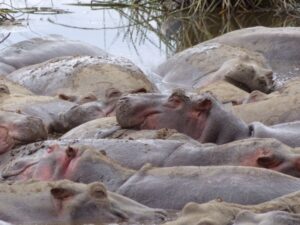 Day Eight – 3° 9′ 15″ South, 35° 40′ 34″ East, 7880 feet elevation
Day Eight – 3° 9′ 15″ South, 35° 40′ 34″ East, 7880 feet elevation
But that’s later. Upon viewing the Ngorongoro crater from above, it just appears as a vast empty space. That couldn’t be further from the truth. When perched at any scenic overlook, you are 1800 feet above the crater floor. When you descend, you realize it’s teeming with wildlife. More zebras and wildebeest, plus baboons, ostriches, warthogs, hyenas, jackals, the aforementioned lions, black rhino, and hippopotamus. Lots of hippos. At the “hippo pool” there were at least a hundred. Even more were at a completely separate watering hole. A group of flamingos put on a display of flying in unison around one of the marshes. It was quite a site and we captured it on camera. And alas, we found the black rhino, the last of the animals we were seeking. We never saw crocodiles, but they do not live at Ngorongoro. Our group wasn’t the only one seeking the elusive rhino. It seems everyone else was. When word got out that someone had spotted the rhinos, every land cruiser in the park seemed to converged on that spot, creating a rather unique traffic jam. But we did see two rhinos, albeit at a pretty good distance. So when we left to head back towards the northern end of the park, it felt like we had the whole place to ourselves. After seeing all these animals, grazing, sleeping, as well as several lions devouring a fresh kill, we finally caught two lions in the act of making more felines. It was bound to happen. We had caught sight of some lions earlier in the day, but they were doing what most cats do, sleeping, grooming, and more sleeping. Upon our return to the same spot, the big cats were still there. However, one of the males was looking rather listless next to two females. I made a comment to everyone that he looked pretty frisky, and taking my cue, someone started the video on their camera. The next thing we know, our lion is mounting one of the females. The entire encounter lasted no more than twenty five seconds, and a lot of human laughter can be heard in the background, mostly from the females in our group.
It would have been difficult to top that experience, and we slowly wound our way out of the park and up to the Sopa Lodge, which is perched on an overlook affording a spectacular view of the entire crater. It is one of only four lodges in the Ngorongoro Conversation Area. The NCA encompasses 3000 square miles of protected land, whose main feature is the Ngorongoro crater, the world’s largest intact caldera, formed about three million years ago. The rim is mostly tree forest and thickets, while the crater is mostly arid.
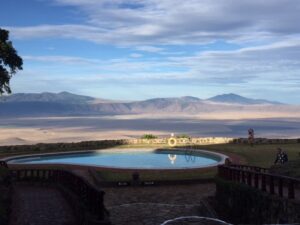 Sopa also boasts no fences, and all guests have to be escorted by the staff to their rooms after dark. Walking back after dinner (with escort,) we saw about half a dozen zebras on the level below us, and as we got closer to the rooms, there was some rustling in the bushes. Our escort shined his flashlight in that direction, revealing a cape buffalo in the foliage. The animal was no more than twenty five feet away, but fortunately heading away from us. When asked about what happens if a large mammal gets closer, since he was nothing other than a walkie-talkie, he informed us that shining the light directly in their eyes is usually enough to scare them away.
Sopa also boasts no fences, and all guests have to be escorted by the staff to their rooms after dark. Walking back after dinner (with escort,) we saw about half a dozen zebras on the level below us, and as we got closer to the rooms, there was some rustling in the bushes. Our escort shined his flashlight in that direction, revealing a cape buffalo in the foliage. The animal was no more than twenty five feet away, but fortunately heading away from us. When asked about what happens if a large mammal gets closer, since he was nothing other than a walkie-talkie, he informed us that shining the light directly in their eyes is usually enough to scare them away.
Day Nine – 3° 22′ South, 36° 41′ East, elevation 4551 feet
Our last day in Africa. We packed up yet again, and left the manor, armed with loads of coffee beans. So much so, that the whole back of the land cruiser smelled like a Starbucks. We made a beeline for the park gate, since our passes only allow twenty-four hour access to the NCA without additional charges. Our destination today was the Kilimanjaro International Airport by way of Arusha. The two hour drive took us back through now familiar territory, past Masai villages, small towns, and farmland under cultivation. I sat in the front seat and peppered Emanuel with lots of questions about the Masai culture. His twenty years of guiding experience including a three year stint as head ranger at premiere game lodge in Tanzania.
We saw a lone giraffe on the side of the road, nibbling on acacia tree leaves, more baboons, and had a beautiful view of Lake Maynara, another potential safari stop. Unfortunately, our itinerary didn’t allow time to peruse it. We stopped for lunch at the Lake Duluth Serena hotel. The hotel building, which once served as a coffee plantation, dates back to the late 1800’s. The guest rooms, whose exteriors were inspired by Masai huts, had lovely views of the gardens and surrounding lake.
Then it was off to the airport where we bid goodbye to Tanzania, with a spectacular view of Kilimanjaro from the south, its summit just peaking above the cloud line. Thirty hours later we arrived back in Chicago with some amazing memories and thousands of photos to prove it.

